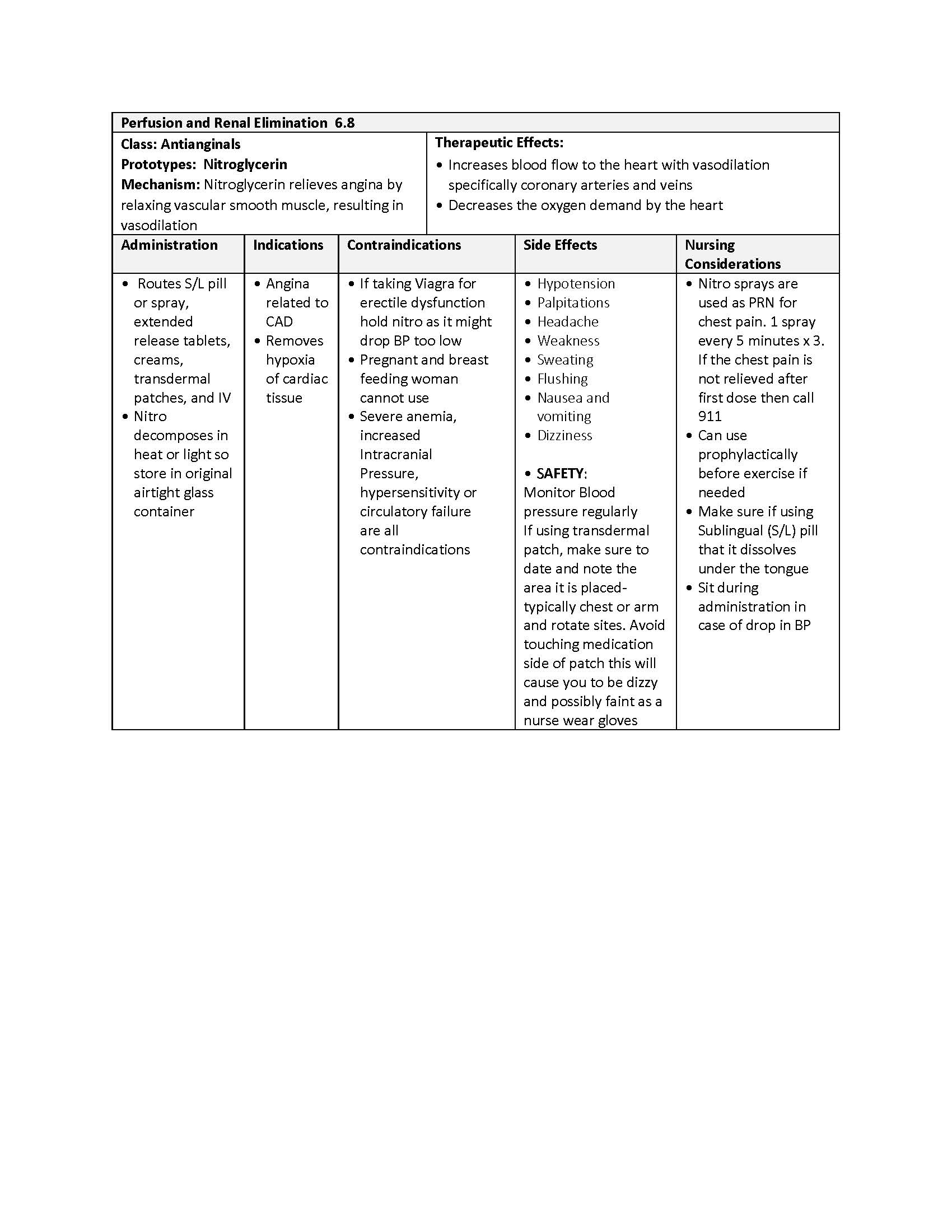Perfusion and Renal Elimination
6.8 Antianginal Drugs
Open Resources for Nursing (Open RN)
Antianginal Drugs
Antianginal drugs are used to treat angina pectoris. Angina is chest pain caused by inadequate blood flow, resulting in hypoxia of the cardiac tissue. Angina can be chronic pain caused by atherosclerosis in coronary artery disease or acute pain caused by a myocardial infarction.
Antianginals increase blood flow to the heart or decrease oxygen demand by the heart. Nitrates promote vasodilation of coronary arteries and veins. Beta blockers and calcium channel blockers are also used to decrease the workload of the heart and oxygen demands.
Nitrates may be administered through a variety of routes, such as sublingual, extended-release tablets, creams, transdermal patches, and intravenously. The grid below focuses on administration via sublingual tablets. Sublingual tablets are prescribed PRN (“as needed”) for clients who are experiencing chronic, stable angina due to coronary artery disease.
Mechanism of Action
Nitroglycerin relieves angina by relaxing vascular smooth muscle, resulting in vasodilation.
Indications for Use
Nitroglycerin is used to relieve angina due to coronary artery disease, during times of an acute attack, or prophylactically.
Nursing Considerations Across the Lifespan
Clients taking sildenafil (Viagra) or similar medications for erectile dysfunction in the previous 24 hours may not take nitroglycerin as this may result in a dangerous drop in blood pressure.
Nitroglycerin should not be used in pregnant women or those who are breastfeeding.
Nitroglycerin is contraindicated in clients who have severe anemia, increased intracranial pressure, hypersensitivity, or circulatory failure.
Adverse/Side Effects
Clients taking nitroglycerin may experience hypotension, palpitations, headache, weakness, sweating, flushing, nausea, vomiting, or dizziness.
Clients should allow medication to dissolve under their tongue. This route allows immediate absorption into the circulation and avoids first-pass metabolism by the liver. Clients may take up to one sublingual tablet every 5 minutes, to a maximum of 3 tablets within 15 minutes, to relieve chest pain. If chest pain is not relieved after the first dose, 911 should be called. Nitroglycerin may also be used prophylactically 5 to 10 minutes prior to engaging in activities that might precipitate an acute attack.
Client Teaching & Education
Instruct client to avoid eating or smoking during administration as this may alter absorption. Clients should sit during administration to decrease the risk for injury due to the possibility of hypotension, dizziness, and weakness. Nitroglycerin decomposes when exposed to heat or light, so it should be stored in the original, airtight glass container. See Figure 6.8[1] for an image of nitroglycerin containers.[2]
Historically, clients have been taught to seek emergency help (call 911) if pain persists after the 3rd dose of medication. However, new guidelines from the American Heart Association urge clients to call 911 after the first dose if symptoms are not improved or become worse.[3]

Now let’s take a closer look at the medication card for nitroglycerin in Table 6.8.[4]
Table 6.8 Nitroglycerine Medication Card

Clinical Reasoning and Decision-Making Activity 6.8a

A client was administered the first dose of nitroglycerin at 1305hrs for acute angina. What should the nurse evaluate after administration?
Note: Answers to the Critical Thinking activities can be found in the “Answer Key” sections at the end of the book.
Media Attributions
- Nitroglycerin
- "Nitroglycerin (1).JPG" by Intropin is licensed under CC BY 3.0 ↵
- This work is a derivative of Daily Med by U.S. National Library of Medicine in the public domain. ↵
- O’Gara, P., Kushner, F. , Ascheim, D. , Casey, D., Chung, M., de Lemos, J., Ettinger, S., Fang, J, Fesmire, F., Franklin, B., Granger, C., Krumholz, H., Linderbaum, J., Morrow, D., Newby, L., Ornato, J., Ou, N., Radford, M., Tamis-Holland, J., Tommaso, C., Tracy, C., Woo, Y., & Zhao, D. (2013). ACCF/AHA guideline for the management of ST-elevation myocardial infarction: a report of the American College of Cardiology Foundation/American Heart Association task force on practice guidelines. Circulation, 127(4). https://www.ahajournals.org/doi/full/10.1161/CIR.0b013e3182742cf6?url_ver=Z39.88-2003&rfr_id=ori%3Arid%3Acrossref.org&rfr_dat=cr_pub%3Dpubmed ↵
- This work is a derivative of Daily Med by U.S. National Library of Medicine in the public domain. ↵

